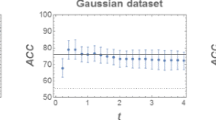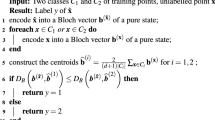Abstract
We introduce a framework suitable for describing standard classification problems using the mathematical language of quantum states. In particular, we provide a one-to-one correspondence between real objects and pure density operators. This correspondence enables us: (1) to represent the nearest mean classifier (NMC) in terms of quantum objects, (2) to introduce a quantum-inspired version of the NMC called quantum classifier (QC). By comparing the QC with the NMC on different datasets, we show how the first classifier is able to provide additional information that can be beneficial on a classical computer with respect to the second classifier.





Similar content being viewed by others
Notes
Hence, as a pattern is an object characterized by the knowledge of its features, analogously, in quantum mechanics a state of a physical system is represented by a density operator, characterized by the knowledge of its observables.
In the standard pattern recognition theory, the symbol y is generally used to identify the label of the pattern. In this paper, for the sake of simplicity, we agree with a different notation.
Let us remark that, in general, \(a^*\) and \(b^*\) do not represent true centroids, but centroids estimated on the training set.
For the sake of the simplicity, from now on, we indicate \(\sum _{j=1}^C \mathrm{TP}_j\) with TP. Similarly for TN, FP, and FN.
This make sense because it can be seen that for all the datasets we deal with, the classification error is very similar both with and without splitting training and test sets.
Let us remark that there are some patterns correctly classified by the NMC which are neglected by the QC. On this basis, exploiting their complementarity, in principle it also makes sense to consider a combination of both classifiers.
In this case, by combining QC and NMC together, the mean error decreases up to about \(0.247\ (\pm 4.280)\).
Similarly to the Gaussian case, also for the Banana dataset, the NMC is able to correctly classify some points unclassified by the QC. Indeed, by considering the combination of both classifiers, the mean error can decrease up to 10%.
References
Aerts D, D’Hooghe B (2009) Classical logical versus quantum conceptual thought: examples in economics, decision theory and concept theory. Quantum interaction (Lecture Notes in Computer Science), vol 5494. Springer, Berlin, pp 128–142
Aerts D, Gabora L, Sozzo S (2013) Concepts and their dynamics: a quantum-theoretic modeling of human thought. Top Cogn Sci 5(4):737–772
Aharonov D, Kitaev A, Nisan N (1998) Quantum circuits with mixed states. In: Proceedings of the 30th annual ACM symposium on theory of computing, pp 20–30. ACM
Barnett SM (2009) Quantum information, 16, Oxford Master Series in Physics. Oxford University Press, Oxford. Oxford Master Series in Atomic, Optical, and Laser Physics
Beltrametti E, Chiara ML Dalla, Giuntini R, Leporini R, Sergioli G (2014a) A quantum computational semantics for epistemic logical operators. Part II: semantics. Int J Theor Phys 53(10):3293–3307
Beltrametti E, Chiara ML Dalla, Giuntini R, Leporini R, Sergioli G (2014b) A quantum computational semantics for epistemic logical operators. Part I: epistemic structures. Int J Theor Phys 53(10):3279–3292
Bennett CH, Shor PW (1998) Quantum information theory. IEEE Trans Inf Theory 44(6):2724–2724
Bertlmann RA, Krammer P (2008) Bloch vectors for qudits. J Phys A 41(23):235303
Caraiman S, Manta V (2012) Image processing using quantum computing. In: IEEE 16th international conference on system theory, control and computing (ICSTCC), 2012, pp 1–6
Chefles A (2000) Quantum state discrimination. Contemp Phys 41(6):401–424. arXiv:quant-ph/0010114
Chiang H-P, Chou Y-H, Chiu C-H, Kuo S-Y, Huang Y-M (2013) A quantum-inspired Tabu search algorithm for solving combinatorial optimization problems. Soft Comput 18(9):1771–1781
Coxeter HSM (1969) Introduction to geometry, 2nd edn. Wiley, New York
Chiara ML Dalla, Giuntini R, Greechie R (2004) Reasoning in quantum theory: sharp and unsharp quantum logics, vol 22. Springer Science and Business Media, Berlin
Duda RO, Hart PE, Stork DG (2000) Pattern classification, 2nd edn. Wiley Interscience, Hoboken
Eisert J, Wilkens M, Lewenstein M (1999) Quantum games and quantum strategies. Phys Rev Lett 83(15):3077
Eldar YC, Oppenheim AV (2002) Quantum signal processing. IEEE Sig Process Mag 19(6):12–32
Fawcet T (2006) An introduction to ROC analysis. Pattern Recogn Lett 27(8):861–874
Freytes H, Sergioli G, Aricò A (2010) Representing continuous \(t\)-norms in quantum computation with mixed states. J Phys A 43(46):465306 12
Giovannetti V, Lloyd S, Maccone L (2008) Quantum random access memory. Phys Rev Lett 100(16):160501
Hastie T, Tibshirani R, Friedman J (2001) The elements of statistical learning. Springer, Berlin
Hayashi A, Horibe M, Hashimoto T (2005) Quantum pure-state identification. Phys Rev A 72(5):052306
Helstrom CW (1976) Quantum detection and estimation theory. Academic Press, Cambridge
Jaeger G (2007) Quantum information. Springer, New York (An overview, With a foreword by Tommaso Toffoli)
Jaeger G (2009) Entanglement, information, and the interpretation of quantum mechanics. Frontiers Collection. Springer, Berlin
Jakóbczyk L, Siennicki M (2001) Geometry of Bloch vectors in two-qubit system. Phys Lett A 286(6):383–390
Karlıǧa B (1996) On the generalized stereographic projection. Beiträge Algebra Geom 37(2):329–336
Kimura G (2003) The Bloch vector for N-level systems. Phys Lett A 314(56):339–349
Kimura G, Kossakowski A (2005) The Bloch-vector space for N-level systems: the spherical-coordinate point of view. Open Syst Inf Dyn 12(03):207–229. arXiv:quant-ph/0408014
Kolossa D, Haeb-Umbach R (2011) Robust speech recognition of uncertain or missing data: theory and applications. Springer Science and Business Media, Berlin
Lloyd S, Mohseni M, Rebentrost P (2013) Quantum algorithms for supervised and unsupervised machine learning. arXiv:1307.0411
Lloyd S, Mohseni M, Rebentrost P (2014) Quantum principal component analysis. Nat Phys 10(9):631–633
Lu S, Braunstein SL (2014) Quantum decision tree classifier. Quantum Inf Process 13(3):757–770
Manju A, Nigam MJ (2014) Applications of quantum inspired computational intelligence: a survey. Artif Intell Rev 42(1):79–156
Manning CD, Raghavan P, Schütze H (2008) Introduction to information retrieval, vol 1. Cambridge university press, Cambridge
Miszczak JA (2012) High-level structures for quantum computing, 6 synthesis (Lectures on Quantum Computing). Morgan and Claypool Publishers, San Rafael
Nagel E (1963) Assumptions in economic theory. Am Econ Rev 53(2):211–219
Nagy M, Nagy N (2016) Quantum-based secure communications with no prior key distribution. Soft Comput 20(1):87–101
Nielsen MA, Chuang IL (2000) Quantum computation and quantum information. Cambridge University Press, Cambridge
Ohya M, Volovich I (2011) Mathematical foundations of quantum information and computation and its applications to nano- and bio-systems. Theoretical and Mathematical Physics. Springer, Dordrecht
Ostaszewski M, Sadowski P, Gawron P (2015) Quantum image classification using principal component analysis. Theor Appl Inf 27:3. arXiv:1504.00580
Rebentrost P, Mohseni M, Lloyd S (2014) Quantum support vector machine for big feature and big data classification. Phys Rev Lett 113:130503
Sause MGR, Horn S (2013) Quantification of the uncertainty of pattern recognition approaches applied to acoustic emission signals. J Nondestruct Eval 32(3):242–255
Schuld M, Sinayskiy I, Petruccione F (2014a) An introduction to quantum machine learning. Contemp Phys 56(2). arXiv:1409.3097
Schuld M, Sinayskiy I, Petruccione F(2014b) Quantum computing for pattern classification. In: PRICAI 2014: trends in artificial intelligence, pp 208–220. Springer
Schuld M, Sinayskiy I, Petruccione F (2014c) The quest for a quantum neural network. Quantum Inf Process 13(11):2567–2586
Schwartz JM, Stapp HP, Beauregard M (2005) Quantum physics in neuroscience and psychology: a neurophysical model of mind-brain interaction. Philos Trans R Soc B Biol Sci 360(1458):1309–1327
Shannon CE (1948) A mathematical theory of communication. Bell Syst Tech J 27(379–423):623–656
Sozzo S (2015) Effectiveness of the quantum-mechanical formalism in cognitive modeling. Soft Comput. doi:10.1007/s00500-015-1834-y
Stapp HP (1993) Mind, matter, and quantum mechanics. Springer, Berlin
Tanaka K, Tsuda K (2008) A quantum-statistical-mechanical extension of gaussian mixture model. J Phys Conf Ser 95(1):012023
Trugenberger CA (2002) Quantum pattern recognition. Quantum Inf Process 1(6):471–493
Webb AR, Copsey KD (2011) Statistical pattern recognition, 3rd edn. Wiley, New York
Wiebe N, Kapoor A, Svore KM (2015) Quantum nearest-neighbor algorithms for machine learning. Quantum Inf Comput 15(34):0318–0358
Wilde MM (2013) Quantum Inf Theory. Cambridge University Press, Cambridge
Wittek P (2014) Quantum machine learning: what quantum computing means to data mining. Academic Press, Cambridge
Acknowledgements
This work has been partly supported by the project “Computational quantum structures at the service of pattern recognition: modeling uncertainty” (CRP-59872) funded by Regione Autonoma della Sardegna, L.R. 7/2007 (2012) and the FIRB project “Structures and Dynamics of Knowledge and Cognition” (F21J12000140001).
Funding This study was funded by Regione Autonoma della Sardegna, L.R. 7/2007, CRP-59872 (2012).
Author information
Authors and Affiliations
Corresponding author
Ethics declarations
Conflict of interest
The authors declare that they have no conflict of interest.
Ethical approval
This article does not contain any studies with human participants or animals performed by any of the authors.
Additional information
Communicated by A. Di Nola.
Rights and permissions
About this article
Cite this article
Sergioli, G., Santucci, E., Didaci, L. et al. A quantum-inspired version of the nearest mean classifier. Soft Comput 22, 691–705 (2018). https://doi.org/10.1007/s00500-016-2478-2
Published:
Issue Date:
DOI: https://doi.org/10.1007/s00500-016-2478-2




